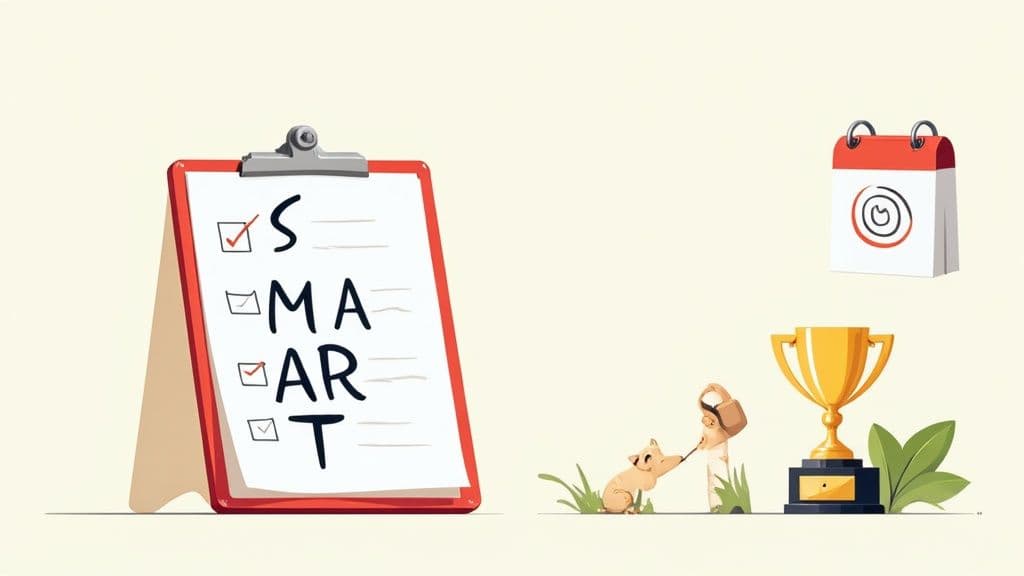Stop drifting and start designing your future. A life plan helps you move from reactive choices to intentional living by aligning daily actions with your deepest values and long-term vision.
June 26, 2025 (4mo ago) — last updated October 25, 2025 (3d ago)
How to Create a Life Plan That Works
Stop drifting and design a life that matches your values. Practical steps to build a lasting life plan across career, health, relationships, and legacy.
← Back to blog
How to Create a Life Plan That Works
Summary: Stop drifting and design a life that matches your values. Practical steps to build a lasting life plan across career, health, relationships, and legacy.
Introduction
Stop drifting and start designing your future. A life plan helps you move from reactive choices to intentional living by aligning daily actions with your deepest values and long-term vision.
Crafting a life plan is more than listing goals. It’s creating a flexible roadmap that keeps you headed toward what matters, even when life changes direction.
Why a Life Plan Is Your Compass, Not a Cage
We’ve all set New Year’s intentions that fade by February. The issue usually isn’t desire—it’s approach. When we chase isolated achievements like “get a promotion” without a bigger context, progress feels hollow.
A life plan acts like a personal compass. It’s a living guide that reflects your core values and clarifies how choices fit into the life you’re building. Even when you detour, a clear compass shows whether you’re still headed toward your “North Star.”
Why You Need a Life Plan Now
In a world full of notifications and distraction, a personal plan is essential for focus and well-being. Planning helps you adapt to change without losing sight of what matters and can reduce the anxiety of feeling directionless.
Global life expectancy has been rising, which gives many people more opportunities for career changes, new hobbies, and evolving relationships—making long-term planning increasingly important.1
A solid life plan also makes it easier to say “no” to energy drains and “yes” to what lights you up.
A life plan simplifies decision-making. When you’re at a crossroads, ask: “Does this move me closer to the life I truly want?” That question brings clarity.
From To-Do Lists to a True Vision for Your Life
A life plan isn’t just about career or money. It asks: what does a fulfilling life look like for you across every area? A holistic plan weaves together threads like personal growth, relationships, health, and contribution.
Key life threads to consider:
- Personal growth: What skills or inner changes do you want?
- Relationships: How do you want to show up for family and friends?
- Health & wellness: What does feeling energetic and resilient mean to you?
- Contribution & legacy: What mark do you want to leave on your community?
Seeing life as an integrated whole prevents professional success from coming at the cost of personal burnout. For background on life-planning concepts, see resources that outline how to structure long-term personal goals and plans.
What Really Drives You? Discovering Your Core Values

Core values are your internal guide. Without them, goals sit on shaky ground. For example, “wealth” can mean freedom, security for family, or ability to fund causes. Getting to the root of what those words mean for you is the first step.
Move Beyond Surface-Level Desires
Be a detective of your own life. Look at peak moments—when did you feel most alive? Who were you with? Those moments reveal values. Also note what drains you; friction often signals violated values.
If you need structure, a short quiz or guided exercise can help uncover themes and sharpen your language for values. Use these insights to create a prioritized list of 5–7 core values to filter decisions and opportunities.
A Simple Framework for Identifying Values
| Life Area | Peak Experience | Underlying Value | Priority |
|---|---|---|---|
| Career | Leading a project that helped team members grow | Mentorship & impact | High |
| Relationships | A deep, honest conversation with a friend | Connection & authenticity | High |
| Health | Completing a challenging hike feeling energized | Vitality & perseverance | Medium |
| Personal Growth | Learning a new language | Curiosity & learning | High |
Once you have 5–7 core values, use them as a filter: does this job, relationship, or commitment honor those values?
Crafting Your Vision Across Key Life Areas

With core values as your compass, paint vivid visions for different life domains so one area doesn’t consume everything. Common domains include:
- Career & work: What impact and environment do you want?
- Health & wellness: How do you want to feel daily?
- Finances & wealth: What does security or freedom look like?
- Relationships & community: How do you want to show up?
- Personal growth & learning: What do you want to explore?
Use Time Horizons to Make the Vision Concrete
Project each domain into time horizons to make dreams tangible:
- Five years: realistic milestones.
- Ten years: long-term transformation.
- Twenty years: legacy and the mark you leave.
For example, if “impact” is a core value, your career plan might progress from leading a small team (5 years) to directing major initiatives (10 years) to mentoring the next generation (20 years).
International indexes show wide differences between countries in work-life balance, which affects people’s ability to design lives that match their values.2
A life plan is not just goals; it’s a story you tell yourself about the future. The more detailed that story, the easier it is to act on it.
Turning Vision Into Actionable Steps
A vision motivates, but action moves you forward. Reverse-engineer big goals into concrete steps by working backward from your long-term vision to what you can do today.
From Grand Vision to Ground-Level Tasks
Break a 10-year vision into 5-year milestones, then annual goals, then monthly and weekly actions. For example, financial independence might look like:
- Long-term: Live off investment income.
- Medium-term (3–5 years): Max out retirement accounts and build taxable investments.
- Short-term (1 year): Create and stick to a budget; eliminate high-interest debt.
- Immediate (this month): Track every dollar for 30 days and set an automatic transfer to savings.
Each small win fuels the next one.
Prioritizing for Maximum Impact
Sequence tasks and assign deadlines. Identify what must come first, what runs in parallel, and what can wait. Use a three-step workflow: identify key tasks, sequence by priority, assign deadlines. Keeping a polished resume or professional profile ready is practical when career opportunities arise—tools like a resume builder can help streamline that process.
The aim isn’t a rigid schedule. It’s a default path so when you have a spare hour, you know exactly what to work on next.
Building Your Personal Life Plan Document

Consolidate your values, visions, and goals into a single, living document you’ll actually use. Choose a format that fits your routine: a physical journal, digital tools like Notion or Evernote, or a simple Google Doc or spreadsheet.
Structure Your Life Plan Document
A clear structure makes the plan easy to review:
- Core principles: 5–7 values and a brief mission statement.
- Vision statements: one page per life domain.
- Goals & milestones: long-term, medium-term, short-term.
- Legacy & financials: bigger-picture financial plans and legacy goals.
Regularly review and update the document so it grows as you do. Thoughtful life planning—covering both emotional and financial elements—is increasingly common as people seek durable life strategies.3
Common Hurdles and How to Move Past Them
You’ll hit bumps. That’s normal. Treat them as pit stops for recalibration rather than failures.
What If I’m Feeling Stuck and Uninspired?
Don’t try to force inspiration. Shift from planning to experiencing. Try an “artist date,” talk to interesting people, or sign up for a low-stakes class. New experiences generate new ideas.
If you feel disconnected, revisit your core values and recent peak experiences. Those reminders often cut through the fog.
How Often Should I Look at This Plan?
A layered review rhythm keeps you connected without being burdensome:
- Weekly: quick glance at the week’s priorities.
- Monthly: check progress against quarterly goals.
- Quarterly: deeper review of the year’s trajectory.
- Annual: celebrate wins, learn, and set new intentions.
How Do I Stick With It When Life Gets Crazy?
Aim for minimum viable progress. Schedule priorities like appointments. Build breathing room into your calendar so unexpected events don’t derail your entire plan.
Your plan should reduce stress, not add to it. Use it to identify what’s essential and what can wait.
The Life Purpose App is built to be a companion on this journey—helping you uncover your path and plan with tools that support long-term thinking. Get started for free at https://lifepurposeapp.com.
Quick Q&A
Q: What’s the first step in creating a life plan?
A: Start by identifying 5–7 core values from peak experiences. Those values become the filter for every decision.
Q: How do I make big goals manageable?
A: Reverse-engineer your 10-year vision into 5-year milestones, then yearly, monthly, and immediate actions.
Q: How often should I review my life plan?
A: Use a layered rhythm—weekly for priorities, monthly for progress, quarterly for adjustments, and an annual vision meeting.
Discover Your Life Purpose Today!
Unlock your true potential and find your life’s purpose.
